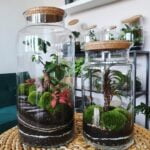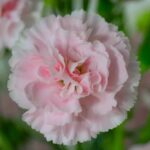Container Ideas for Herb Gardens: Enhancing your home with fresh herbs has never been easier or more stylish. In this article, we will explore the benefits of growing herbs in containers and the importance of choosing the right containers for your herb garden. Whether you have limited space, are looking to repurpose household items, or want to customize your herb garden, we have innovative and practical ideas to suit every need.
From small apartments to spacious balconies, there’s a container solution for everyone. Let’s get started on creating a beautiful and functional herb garden right at home.
Growing herbs in containers offers numerous advantages, including accessibility, convenience, and the ability to control soil quality and drainage. Choosing the right containers is crucial for the health and growth of your herbs, so it’s essential to consider different factors such as material, size, and drainage options when selecting containers for your herb garden. Our guide will help you make informed choices to ensure successful herb cultivation in containers.
Whether you’re living in a small apartment or simply want to add a touch of greenery to your indoor space, we have creative ideas for utilizing vertical space and maximizing available surfaces for growing herbs. Additionally, we’ll explore the art of upcycling everyday household items into unique herb containers while promoting sustainability in gardening practices. Get ready to transform your living space with our container ideas for herb gardens.
Small Spaces, Big Flavors
Living in an apartment or small living space doesn’t mean you have to miss out on the joy of growing your own herbs. With the right container ideas for herb gardens, you can enjoy fresh herbs and add big flavors to your meals, even in limited spaces. From vertical gardens to hanging planters, there are numerous creative ways to make the most of your apartment for herb gardening.
Utilizing Vertical Space for Herb Gardens
When it comes to apartment living, maximizing vertical space is essential for creating a thriving herb garden. Consider installing a vertical planter on a sunny wall or balcony to grow a variety of herbs without taking up valuable floor space. You can also use hanging planters near windows or on railings to create a beautiful and functional herb garden while adding visual appeal to your living space.
Creative Ideas for Small Living Spaces
In addition to utilizing vertical space, there are numerous creative ideas for growing herbs in small living spaces. For example, you can repurpose old shoe organizers by hanging them on the back of a door and planting different herbs in each pocket.
Another idea is to use stacked wooden crates or pallets as tiered planters, allowing you to grow a variety of herbs in a compact footprint. These innovative container ideas not only maximize space but also add charm and character to your apartment herb garden.
Taking advantage of the available space and using creative container ideas for herb gardens will allow you to enjoy fresh herbs and elevate your culinary creations, all within the confines of your apartment. Whether it’s utilizing vertical space, repurposing household items as containers, or simply getting creative with limited square footage, there are plenty of options available for creating a thriving container herb garden in any small living space.
Repurposing Household Items for Herb Containers
When it comes to creating a container herb garden, you don’t have to break the bank buying expensive pots and planters. In fact, there are plenty of everyday household items that can be repurposed into unique and creative containers for your herbs. Not only does this approach add a personal touch to your garden, but it also promotes sustainability through upcycling.
Here are some innovative ways to repurpose household items for your herb containers:
- Mason jars: These versatile glass jars can be used as charming herb planters. Simply drill a few drainage holes in the bottom, fill with potting soil, and plant your favorite herbs like basil or mint.
- Tin cans: Give old tin cans a new lease on life by transforming them into herb pots. After cleaning and removing any sharp edges, paint the cans in vibrant colors or wrap them with decorative paper for added flair.
- Wooden crates: If you have an old wooden crate lying around, consider turning it into a rustic herb garden. Line the crates with plastic or burlap to prevent soil from spilling out, then fill with herbs such as rosemary and thyme.
Repurposing household items not only adds character to your herb garden but also reduces waste by giving new purpose to old items that would otherwise end up in the landfill.
Get creative and start looking around your home for potential containers that can be turned into unique homes for your favorite herbs. From teacups to shoe organizers, the possibilities for repurposing household items for herb containers are endless.
Seasonal Selection
When it comes to container herb gardens, the possibilities are endless. Whether you have a small balcony or a spacious backyard, growing herbs in containers is a convenient and rewarding way to enjoy fresh flavors year-round. One of the key factors in successful container gardening is choosing the right herbs for each season. Here are some seasonal selection tips for cultivating an abundant herb garden in containers:
- Spring: During the spring months, consider planting herbs like basil, chives, and parsley. These herbs thrive in the mild temperatures and longer daylight hours of spring, making them ideal choices for container gardens.
- Summer: As temperatures rise, opt for heat-tolerant herbs such as rosemary, thyme, and oregano. These Mediterranean herbs love the sun and can add bold flavors to your summer dishes.
- Fall: When the weather cools down, shift your focus to cool-season herbs like cilantro, dill, and mint. These herbs prefer cooler temperatures and will continue to thrive well into the fall season.
- Winter: For winter herb gardening, choose hardy varieties such as sage, lavender, and winter savory. These cold-resistant herbs can withstand frost and even snow, providing fresh flavors during the winter months.
In addition to selecting the right herbs for each season, it’s important to pay attention to the specific needs of your plants as they grow in containers. Proper watering, pruning, and fertilization are essential for maintaining healthy and productive container herb gardens throughout the year. With careful planning and seasonal adjustments, you can enjoy a thriving herb garden no matter what time of year it is.
As you plan your seasonal container herb garden, don’t forget to consider the visual appeal of your planters. Choosing containers that complement the colors and textures of your chosen herbs can elevate your garden from functional to stunning.
And with a bit of creativity and personalization – whether through repurposed household items or DIY creations – you can turn your seasonal selection of herb containers into a beautiful display that enhances any living space while providing an abundant harvest of fresh flavors.
Herb Garden Design
When it comes to herb garden design, the choice of containers can have a significant impact on the overall aesthetic appeal of your garden. Stylish and creative containers not only enhance the visual aspect but also provide a functional and practical space for your herbs to thrive. There are countless container ideas for herb gardens that can help create a stunning display in any setting.
One popular idea for stylish herb containers is using decorative pots and planters. These can come in a variety of shapes, sizes, and materials such as ceramic, terracotta, or even colorful plastic. Choosing containers with intricate designs or interesting patterns can add a touch of elegance to your herb garden while still providing a suitable environment for your plants to grow.
Another creative option is to use hanging baskets or wall-mounted planters for your herb garden. These are particularly useful for those with limited space as they allow you to maximize vertical space. Vertical herb gardens not only look visually striking but also make it easy to harvest and maintain your herbs.
Using repurposed items such as old crates, wooden boxes, or even mason jars can also add a unique and rustic charm to your herb garden design. Not only does this contribute to upcycling and sustainability in gardening, but it also allows for personalization and customization of your herb containers.
| Container Type | Description |
|---|---|
| Decorative Pots/Planters | Various shapes, sizes, materials; intricate designs; elegant aesthetic |
| Hanging Baskets/Wall-Mounted Planters | Maximize vertical space; visually striking; easy harvesting |
| Repurposed Items (crates, wooden boxes, mason jars) | Rustic charm; upcycling/sustainability; personalization |
DIY Herb Containers
Personalizing your herb garden with DIY containers is a fun and creative way to showcase your gardening skills and add a unique touch to your living space. Whether you’re upcycling old items or crafting your own planters from scratch, there are plenty of options for creating personalized containers for your herbs.
Step-by-Step Guide for Creating Personalized Herb Containers
One simple and cost-effective way to personalize your herb containers is by painting or decorating plain terra cotta pots. You can use acrylic paint to add colorful designs or patterns that match your personal style. Another option is to stencil on the names of the herbs you’re growing, adding a charming and practical touch to your containers.
For a more hands-on approach, consider making your own herb planters using recycled materials such as wooden crates, mason jars, or tin cans. Not only does this allow for customization in terms of size and shape, but it also promotes sustainability by repurposing items that would otherwise go to waste.
Ideas for Adding a Personal Touch to Herb Containers
In addition to decorative elements, consider adding functional features to your DIY herb containers. For example, attaching chalkboard labels or small hanging baskets can help keep track of different herbs and provide extra storage for gardening tools. You can also incorporate drainage systems using rocks or pebbles at the bottom of the containers to ensure proper water flow for healthy herb growth.
Experimenting with different materials such as wood, fabric, or metal can also add variety and visual interest to your customized herb containers. Get creative with embellishments like ribbons, twine, or even small sculptures to make each container truly one-of-a-kind.
Whether you’re a seasoned crafter or just starting out with DIY projects, personalizing your herb containers is a fantastic way to express yourself while nurturing beautiful and flavorful herbs. With the freedom to design according to your taste and preferences, you’ll have an herb garden that’s not only productive but also reflects your unique personality.
Maintenance and Care for Container Herb Gardens
Container herb gardens are a convenient and accessible way to enjoy fresh herbs year-round, but they do require some maintenance and care to ensure optimal growth and health of the plants. One of the most important aspects of caring for herb containers is proper watering.
Herbs in containers can dry out quickly, especially during warmer months, so it’s essential to check the soil moisture regularly and water as needed. Overwatering can also be detrimental to herb plants, so it’s crucial to find the right balance.
In addition to watering, container herbs will benefit from regular pruning and harvesting. This not only encourages new growth but also prevents the plants from becoming too leggy or overcrowded. It’s best to prune herbs in the morning when their essential oils are most concentrated.
Routine maintenance also includes keeping an eye out for any signs of pests or diseases that can affect herb plants. Inspecting the leaves and stems for discoloration or damage can help catch issues early on.
Another important aspect of caring for container herb gardens is providing them with adequate sunlight and nutrition. Most herbs thrive in full sun, so placing the containers in a sunny location is ideal. Fertilizing container herbs every 4-6 weeks during the growing season can help support healthy growth and abundant foliage. Using a balanced, water-soluble fertilizer diluted to half its strength is recommended.
Lastly, choosing appropriate containers that provide good drainage is crucial for maintaining healthy herb gardens. Containers should have drainage holes at the bottom to prevent waterlogged soil, which can lead to root rot. Additionally, using high-quality potting mix specifically formulated for containers will help provide the necessary nutrients and structure for optimal herb growth.
| Care Tips | Details |
|---|---|
| Watering | Check soil moisture regularly; avoid overwatering. |
| Pruning/Harvesting | Routine pruning promotes new growth and prevents overcrowding. |
| Sunlight/Nutrition | Place containers in sunny locations; fertilize every 4-6 weeks. |
| Containers | Choose containers with proper drainage holes; use high-quality potting mix. |
The Versatility of Container Herb Gardens
In conclusion, container herb gardens offer a multitude of benefits and opportunities for gardeners, regardless of the space available. The versatility of these gardens allows individuals to enjoy fresh herbs and enhance their living spaces with minimal effort. From small apartments to spacious balconies, there are numerous creative ideas for growing herbs in containers that cater to different lifestyles and preferences.
One of the key advantages of container herb gardens is the ability to adapt them to various living spaces. Whether you have a windowsill, balcony, or small garden area, there are container ideas for herb gardens that can maximize your growing potential. By utilizing vertical space, repurposing household items, or personalizing DIY containers, you can create a stunning display while enjoying the flavors and aromas of freshly grown herbs.
Furthermore, the seasonal selection and maintenance tips provided in this article ensure that your container herb garden can thrive year-round. By choosing appropriate herbs for each season and tending to them with care, you can maintain a constant supply of fresh ingredients for culinary endeavors.
Ultimately, the versatility of container herb gardens caters to individuals with different levels of experience in gardening and provides an accessible way to bring nature into any living environment. Whether you consider yourself a seasoned gardener or a novice, there are endless possibilities for cultivating herbaceous treasures in containers.
Frequently Asked Questions
What Is the Best Container to Grow Herbs In?
The best container to grow herbs in is typically one that provides good drainage, as excess water can lead to root rot. Additionally, the container should be large enough to accommodate the herb’s root system and placed in a location with adequate sunlight.
What Is the Best Layout for a Herb Garden?
When considering the layout for a herb garden, it’s important to group herbs with similar water and light requirements together. This will help ensure that each herb receives the optimal conditions for growth. It’s also beneficial to arrange the garden in a way that makes it easy to access and harvest the herbs when needed.
How Deep Should a Container Be for Herbs?
The depth of a container for growing herbs depends on the specific herb being cultivated. In general, most herbs have relatively shallow root systems, so a container that is 6-12 inches deep should be sufficient. However, some herbs such as rosemary or lavender may require deeper containers to accommodate their roots as they mature.

Welcome to my gardening blog! I am passionate about plants and enjoy sharing my knowledge and experiences with others. In this blog, I will write about everything related to gardening, from tips on how to get started to updates on my own garden projects.





